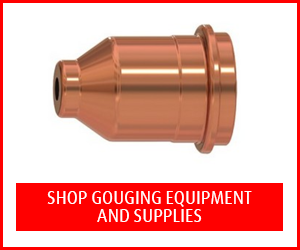Plasma ArcGouging (PAG)
Plasma arc gouging (PAG) is an adaptation of the plasma cutting process where arc constriction is reduced, resulting in a lower arc stream velocity. The temperature of the arc and the velocity of the gas stream melt and expel metal in a similar manner to other gouging processes. Compared to carbon arc gouging, plasma arc gouging produces a bright, clean gouge, particularly on stainless steel and nonferrous materials such as aluminum. Almost no post-cleaning is required prior to welding the plasma-gouged surface. Mixtures of argon with hydrogen are typically used as a plasma gas for gouging operations. The secondary or cooling gas, when used, is typically argon or nitrogen.
The technique for plasma arc gouging is essentially the same as for other gouging methods. The torch is angled approximately 30 degrees from the horizontal, and gouge depth is determined by speed of travel, torch angle and velocity of the plasma jet. It is important not to remove too much metal in a single pass. Plasma arc gouging is most effectively performed with power supplies that produce 200 amps or more.
Why Plasma ArcGouging?
- Can be used on all metals
- Little or no post-cleaning is required before welding
- Particularly effective on aluminum or stainless steel,where the gouges produced are clean without anycarbon contamination
- Low noise when compared with carbon arc gouging
- Low fume when compared with carbon arc gouging
- No need to remove residual carbon from the gougesurface prior to welding operation
Limitations
- May require use of additional protective equipment
- Depth of gouging and accessibility to some areascan be limited by the torch used
- Equipment is less portable than for other gougingprocesses and consumables are more expensive
- High operating voltages present the danger ofelectric shock





























